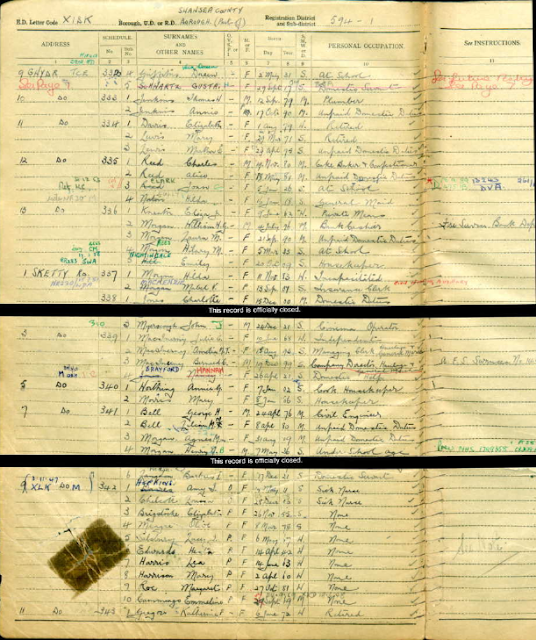PS Waverley (1899) - John Haydn Jones
The PS Waverley (1946) is today the last seagoing passenger-carrying paddle steamer.
Named after Sir Walter Scott’s first novel, Waverley,
1814, the PS Waverley was built in 1946 for the London and North Eastern
Railway, she was to replace the Waverley that was sunk in
1940.
The PS Waverley (1899) was a paddle streamer that
carried passengers on the Clyde between 1899 and 1939. 1902, Waverley was under the ownership
of the North British Railway, resulting in the North British Steam Packet Co.,
being dissolved.
 |
| PS Waverley (1899) |
Launched in May 1899, after completing official trials, she achieved 19.73 knots. Entering service in July 1899.
During the First World War, the Admiralty in 1915
requisitioned the Waverley and saw service on both the British and
Belgian coasts. Discharged from service
in April 1919.
Over a year, the Waverley undertook renovations before
entering back into service in 1920
1923, following the Railways Act 1921, the Waverley
was under the command of the London and North Eastern Railway following its
merger with North British Railway. 1931, the Waverley was superseded as
the fleet's flagship by the newly launched PS Jeanie Deans.
Sadly, during the 1930s, the number of passengers in the
Clyde Estuary deceased steamers were moved to service other routes. Waverley
was removed in 1939.
The Waverley at the outbreak of the Second World War,
was brought back into service evacuating children from Glasgow to areas on the
Clyde coast. Waverley was requisitioned by the Royal Navy, to lead the
ship of the 12th Minesweeping Flotilla, consisting of five paddle
steamers. They were based at Harwick.
28th May 1940, the flotilla was given the orders
and sail south to take part in Operation Dynamo, the codename for the Dunkirk
Evacuation.
The following day, Waverley with over 600 troops on
board was intercepted by twelve German Heinkels whilst returning to the United
Kingdom. Avoided the bombs for 30
minutes, one struck the steamer, resulting in a 6-foot hole in the bottom of the
ship.
Waverley sunk near the Kwint Bank Bouy, with the loss
of some crew and 400 troops. 158
survivors were pulled from the water from Cyclone, 285 from the PS Golden Eagle
and a few Dutch vessels picked a few more.
Sadly, John Haydn Jones was to lose his life in the sinking.
Corporal John Haydn Jones served with the Royal Army Service
Corps attached to the Royal Armoured Corps, 2nd Light Armoured
Reconnaissance Brigade. Age 33
years. John’s death is recorded as being
between the 28th of May and 2nd of June 1940. John was
the son of Rees and Elizabeth Anne Jones; husband of Charlotte Elizabeth Jones,
of Townhill.
 |
| John Haydn Jones Dunkirk Memorial, France credit - findagrave |
His name is also commemorated on his parent’s grave at
Bethel.
Born in Swansea in 1904, John at the time of the 1911 Census
was resident at his parent's home, 20 Alfred Street, Neath. John was their only child
 |
| 1911 Census |
Rees, 41, was employed as a Draper's Assistant. Rees had been born in Ammanford, whilst
Elizabeth, 39, was born in Carmarthen.
Also, present in the property during the census was a 23-year-old
boarder Peter Greenhalgh, who was a Theatre Attendant.
A decade later, the family moved to 16 Cradock Street at the
time of the 1921 Census.
 |
| 1921 Census |
51-year-old Rees is employed as a Shop Walker. Elizabeth is 49. John Haydn is 17, and he is employed as Clerk Shipping.
Also present at the property are several boarders including 31-year-old
Walter Ivor Jenkins, Schoolmaster, from Cresselly, Pembrokeshire. Daniel Morgan
Parry, 22, a Bank Clerk; John Henry Thomas, 20, a Shop Assistant both from
Carmarthen and John Gerwyn Davies, 17, a Bank Clerk from Talley,
Carmarthenshire.
John married in 1934 Charlotte E. I. Myerscough nee.
Jennings. At the time of the wedding, Charlotte
is widowed. Charlotte who had married
previously Robert Justyn Myerscough, who had died in 1932
By the time of the 1939 Register, Rees and Elizabeth are
living at 16 Crole Street.
 |
| 1939 Register |
Charlotte at this time was living at 1 Sketty Road.
 |
| 1939 Register |
Second World War records must be applied for from the Army,
so, it would be difficult to know when John enlisted and when he landed at
France.


Comments
Post a Comment